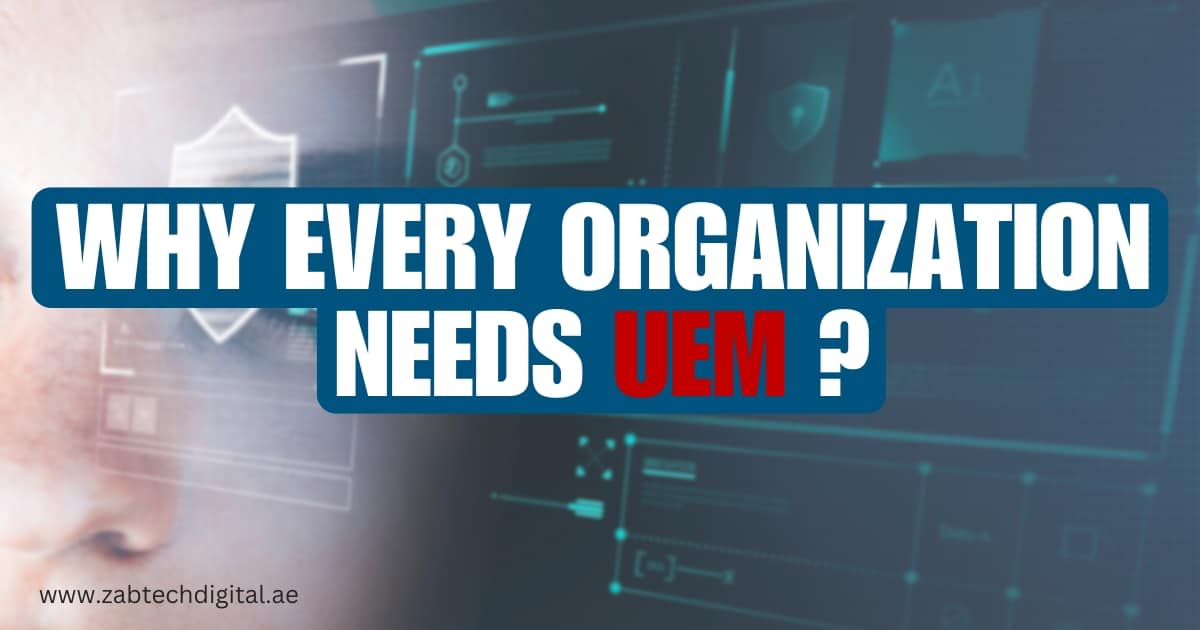
In today’s hyper-connected world, where employees are no longer tethered to a single desk or device, organizations face an unprecedented challenge: managing a diverse array of endpoints—from laptops and smartphones to tablets and wearables—while ensuring security and seamless user experiences. Enter Unified Endpoint Management (UEM), the game-changer that empowers businesses to take control of their digital landscape. In this blog post, we’ll dive into why every organization needs UEM in its arsenal. From enhanced security features that protect sensitive data to streamlined management processes that boost productivity, discover how UEM can transform your workforce’s potential while simplifying IT operations. Buckle up as we explore key features and advantages that make UEM not just an option but a necessity for modern enterprises!
Introduction to UEM (Unified Endpoint Management)
In today’s fast-paced digital landscape, organizations are juggling a multitude of devices—laptops, smartphones, tablets—all connecting to their networks. With the rise of remote work and mobile technology, managing these endpoints has become more crucial than ever. Enter Unified Endpoint Management (UEM), a game-changing solution that simplifies device management across various platforms and environments. But what exactly is UEM? How does it work its magic in streamlining operations while enhancing security? As we delve into the world of UEM, you’ll discover key features that not only bolster productivity but also help safeguard your organization against potential threats. Whether you’re a small business or a large enterprise, understanding the advantages of UEM can transform how you manage your workforce’s devices and data. Get ready to explore why every organization should consider implementing this powerful tool!
What is UEM and how does it work?
Unified Endpoint Management (UEM) is a whole method for handling every endpoint in a company. This includes desktops, laptops, mobile devices, and even IoT gadgets. UEM centralizes management into one platform, simplifying the administrative process.UEM operates by integrating various functions that allow IT teams to monitor and control devices seamlessly. It employs automation for routine tasks like software updates and security patches.By leveraging cloud technology, UEM solutions provide real-time visibility into device status and compliance levels across an organization. Moreover, these systems enable remote access capabilities, allowing users to work securely from any location while maintaining data integrity. The architecture of UEM ensures that organizations can adapt quickly to changing technological landscapes without compromising on performance or user experience.
Unified Endpoint Management (UEM) Key Features:
1.Device Management
- Manages all organization devices, including laptops, smartphones, tablets, and IoT.
- Streamlines new hardware/software deployment and enables real-time performance monitoring.
- Allows remote troubleshooting, resolving issues without physical access.
- Supports automated device enrollment, reducing downtime and enhancing user satisfaction.
- Consolidates device control for secure, efficient operations across the workforce.
2.Application Management
- Centralizes application oversight for installation, updating, and removal across devices.
- Streamlines deployment and update processes, conserving IT resources.
- Enhances user experience with seamless updates and access to new features.
- Tracks software usage to maintain licensing compliance, avoiding legal penalties.
- Improves overall system and employee performance with efficient app management.
3.Security Management
- Provides robust security features, including encryption, remote wipe, and threat detection.
- Standardizes security policies across devices, reducing risks and supporting compliance.
- Automates patch management to counter emerging threats efficiently.
- Enables swift response to security incidents, safeguarding organizational integrity.
- Essential for protecting data in mobile and remote work settings.
4.Content Management
- Centralizes document, media, and data handling across multiple devices.
- Ensures users can access updated files anytime, fostering teamwork and efficiency.
- Facilitates collaboration with easy file sharing and streamlined organization.
- Tracks document versions, ensuring the latest updates are readily accessible.
- Helps with regulatory compliance by maintaining organized, accessible content.
5.Integration with Other Systems
- Connects UEM with existing tools, streamlining workflows and boosting efficiency.
- Facilitates data sharing and real-time insights for improved decision-making.
- Enhances security by integrating with other protective systems, supporting compliance.
- Offers compatibility with popular apps and cloud services for flexible adaptation.
- Improves IT management, enabling proactive solutions and optimized endpoint control.
Advantages of Using UEM for Organizations:
1.Increased Efficiency and Productivity
- Streamlines device management, enabling employees to focus on core tasks.
- Provides seamless access to tools across devices, supporting remote work.
- Automates routine tasks like software updates and security patches, freeing IT teams.
- Centralizes data storage and app access, reducing downtime.
- Enhances collaboration, improving decision-making and project timelines.
2.Enhanced Security and Compliance
- Centralizes security protocols across devices, allowing real-time updates and responses.
- Simplifies compliance with industry regulations through standardized policies.
- Automated reporting aids compliance monitoring without manual effort.
- Integrates strong authentication, reinforcing access control.
3.Cost Savings
- Streamlined device management reduces IT support costs and redundant licenses.
- Improved security protocols lower risks of costly data breaches and compliance fines.
- Efficient workflows boost productivity, allowing employees to focus on key tasks.
4.Better Control and Visibility of Devices and Data
- Provides a consolidated view of all devices, aiding quick identification of unauthorized access.
- Real-time monitoring allows swift responses to security threats.
- Centralized management enforces consistent policies and improves accountability.
- Detailed reports on device status and user activities enable informed decision-making.
Common misconceptions about UEM
Many organizations mistakenly believe that UEM is only for large enterprises. This isn’t true; UEM can benefit businesses of all sizes by simplifying device management and enhancing security.
Another misconception is that implementing UEM requires a complete overhaul of existing systems. In reality, many solutions integrate seamlessly with current infrastructures, minimizing disruption during deployment.
Some think UEM solely focuses on mobile devices. While it does manage smartphones and tablets, it also covers desktops, laptops, and even IoT devices. This comprehensive approach helps maintain uniformity across all endpoints.
Lastly, there’s a belief that adopting UEM means sacrificing user experience for control. However, advanced UEM solutions prioritize both security and usability to ensure employees remain productive while maintaining compliance standards.
How to choose the right UEM solution for your organization
Choosing the right UEM solution for your organization requires careful consideration. Start by assessing your specific needs. Understand the types of devices in use and their unique management requirements.
Next, look for scalability. As your organization grows, so should your UEM capabilities. Ensure that the solution can handle an increasing number of endpoints without performance dips.
Integration is another critical factor. Your UEM should seamlessly connect with existing systems like HR or IT service management tools to facilitate smoother operations.
User experience matters as well. A user-friendly interface will encourage adoption among employees and streamline training processes.
Finally, evaluate vendor support and resources. Reliable customer support can make a significant difference when troubleshooting issues or making upgrades down the line.
Alternatives to UEM and why they may not be as effective
Organizations often consider alternatives to UEM, such as traditional Mobile Device Management (MDM) or endpoint security solutions. While these options can address specific needs, they lack the comprehensive approach that UEM provides.
MDM focuses primarily on device control and may not cover application or content management effectively. This narrow scope can leave gaps in overall device governance.
Endpoint security tools concentrate on protecting devices from threats but do little for application deployment or user experience. Relying solely on these solutions can result in fragmented systems and increased complexity.
Moreover, standalone solutions require separate management efforts. This division leads to inefficiencies and potential non-compliance with regulations. Organizations need an integrated strategy for optimal performance, making UEM a more attractive choice for holistic oversight of all endpoints within a business ecosystem.
Recommendation:
ZabTech supports you with over 30 years of training experience, and further assists with IT services, digital marketing, ICT, cybersecurity, and mobile app solutions across the UAE.
To know more about IT services, digital marketing services, ICT solutions, Cyber security solutions and mobile apps, please Contact Zabtech IT Solutions,
Zabtech offers Unified Endpoint Management Services in Dubai,
For further information please contact:
WhatsApp number: +971 506963432
Email: support@zabtechdigital.ae
Website: https://zabtechdigital.ae/
Facebook: https://www.facebook.com/ZABTechITSolution
LinkedIn: https://www.linkedin.com/company/zabtech-it-solutions/
Twitter: https://twitter.com/Zabtech_Digital
Instagram: https://www.instagram.com/zabtechitsolutions/
To know more about Unified Endpoint Management Services in Dubai,
Conclusion
Unified Endpoint Management (UEM) is crucial as organizations handle an expanding variety of devices and applications. By integrating device management, security protocols, and content oversight, UEM boosts operational efficiency and strengthens cybersecurity. With the right UEM solution, businesses achieve cost savings, better data visibility, and enhanced regulatory compliance—all essential for today’s digital landscape.
While some perceive UEM as complex, real-world cases demonstrate its productivity benefits and risk reduction. Alternatives may fall short in delivering the comprehensive oversight UEM offers, making it the forward-thinking choice for organizations aiming to succeed in a rapidly evolving environment. Embracing UEM is a proactive step toward streamlined management and security.



